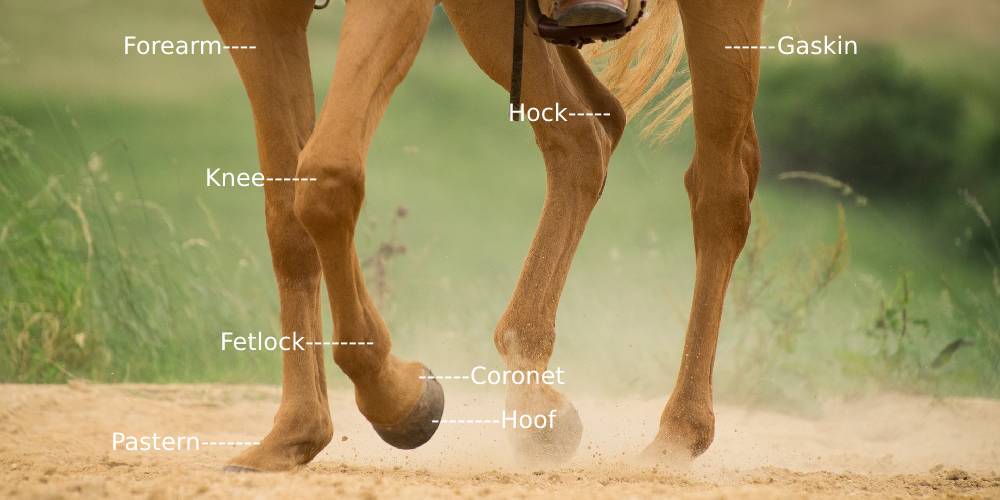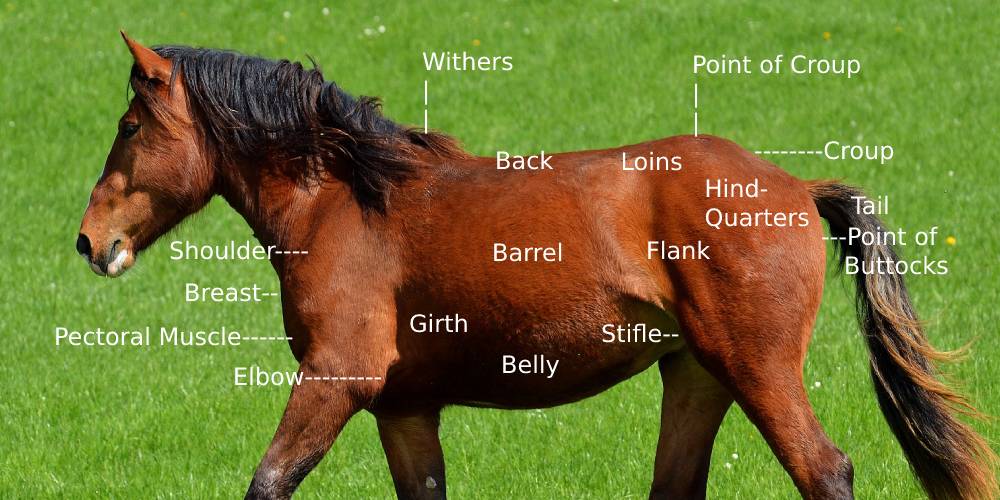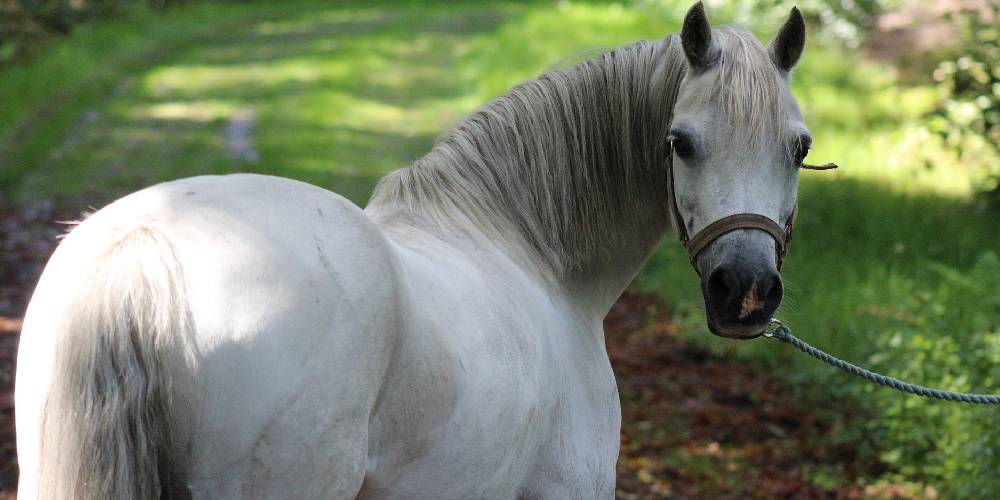There are many different parts of the horse, all of which have special unique names.
I needed to memorize all the parts of the horse for my equine science class, but it was really hard to find a list of the parts of the horse. I made this article so people in my position have an easy list of the parts of the horse to follow.
Alphabetical List Of The Parts Of The Horse:

- Back
- Barrel/Brisket
- Belly
- Breast
- Cannon bone
- Cheek Bone
- Chestnut
- Chin Groove
- Coronet
- Crest
- Croup
- Fetlock
- Flank
- Forearm
- Forelock
- Gaskin
- Girth
- Heel
- Hindquarters
- Hock
- Hoof
- Jowls
- Loins
- Mane
- Muzzle
- Pastern
- Pectoral Muscle
- Point of Buttocks
- Point of Croup
- Poll
- Root of Tail
- Seat of Curb
- Shank
- Shoulder
- Stifle
- Tendon
- Throat
- Withers
This is the list of all the parts of the horse in alphabetical order. I know it may be confusing so I will break it down for you.
Parts Of The Horse’s Leg

In the picture above, it shows all the different parts of the horse’s leg.
Forearm
The horse’s forearm is what the upper part of their front leg is called. If you think about a human’s forearm, it is right above the wrist. This is comparable to the horse’s front leg as their knee is like our wrist, and their forearm is like our forearm. The forearm is pretty much the only part of the horse’s front leg that has muscle. The rest of the leg is controlled by tendons and ligaments.
Knee
The knee of a horse should be a large broad joint to ensure soundness. The knee is a very important part of the horse as it takes a lot of the impact of the upper body and it is a high-motion joint
Fetlock
All four legs have a fetlock joint right above their feet. The fetlock helps to absorb the impact of a horse’s body when their foot hits the ground.
Pastern
The pastern is the bone that is in between the fetlock and the coronet. The ideal pastern is short and strong, too long of a pastern can cause the horse to have soundness issues.
Hock
The hock is the ‘pointy’ joint of the back leg. In an ideal-conformed horse, you should be able to drop a straight line down from the horse’s point of buttocks and it should run down the back of the hock and down the back of the leg.
Gaskin
The gaskin is kind of like the horse’s thigh. This part of the horse is right above the horse’s hock and is pretty much the only part of the horse’s back leg to have muscle. Like the front leg, the rest of the back leg beside the gaskin is controlled by tendons and ligaments.
Coronet
The coronet is basically the line that goes along the top of the hoof where the hoof meets the pastern
Hoof
The hoof is basically the horse’s foot. The hoof often has a shoe nailed onto it to offer the hoof more support and reduce the wear and tear it may have from riding.
To read more on horse shoeing click here.
Parts Of The Horse’s Head and Neck

In the picture above I labeled all the parts of the horse’s head and neck.
Ear
The ears of the horse are one of the best ways to tell what mood they’re in/ If a horse has its ears pricked forward, it means its alert. If a horse has its ears pinned back against its head it means it is angry.
Poll
The poll is the place kind of between the horse’s ears right on top of its head. This is where a terrible thing called poll evil can occur. Poll evil is where inflammation can cause swelling at the poll. This is a nearly untreatable illness so thank goodness it’s rare.
Forelock
The forelock is essentially the continuation of the mane down in front of the horse’s face and between the ears. They are kind of like horse bangs. Some horses who grow a thick long mane and tail have a long forelock that reaches to the end of their nose!
Eye
The horse’s eye is a very special part of the horse. Did you know that horses can have blue eyes? Horses are also able to see nearly 180 degrees on each side!
To learn more about the horse’s eyes and vision click here.
Nostril
The nostril of the horse is usually wide to allow maximum air intake.
Mouth
The horse’s mouth works differently than most mammals on earth. Horses have teeth in the front, as well as molars in the very back. You can also tell the age of the horse by looking at their teeth. Horses are unable to vomit either meaning whatever goes into their mouth can’t come back up their mouth.
To learn more about the horse’s teeth and how to tell the age of a horse click here.
To learn more about how horses can’t vomit and what they do instead click here.
Muzzle
The muzzle is basically the entire nose and mouth area on the horse’s face.
Chin Groove
The chin groove is where the curb chain sits in western riding. The horse’s chin groove falls after the mouth but before the jowls. It is a little dip behind the horse’s chin.
Jugular Groove
The jugular groove is the groove in the horse’s neck along their esophagus.
Cheek/Jowls
The cheeks or the jowls of a horse are the large flat curved areas on the part of the head next to where the neck connects to the head.
Throat
The throat of the horse is just behind the jowls. The throat is also sometimes known as the throat-latch as that’s where the throat-latch of a bridle would sit.
Neck
The horse’s neck is the entire neck area including the crest and the jugular groove.
Crest
The crest of the horse is what the mane sits along. It is often arched with the neck to make the horse appear more elegant and majestic. Some horses get fat deposits on their upper neck making their crest appear bigger and their neck thicker.
Mane
The mane of the horse is just the hair that grows along the neck. Usually the mane falls on either the right or left side of the neck, but I’ve seen horses with half the mane to one side and the other half to the other side.
Parts Of The Rest Of The Horse’s Body

Withers
The withers are an important part of the horse as this is partly how we know where to put the saddle and also how to determine the height of a horse.
To read more about how to measure a horse, click here.
Back
The back is directly behind the withers and this is where the rider sits
Loins
The loins are found directly above the flank and behind the back. This is a sensitive spot on a horse so be careful in this area!
Croup
The croup is behind the point of croup and before the start of the tail. The croup should be strong and should deliver power to the rest of the body. The stronger the croup, the faster the horse.
Point Of Croup
The point of the croup should be level with the withers. If the point of croup is higher, it means that the back end is delivering too much power to the front end. This means that the front end is getting too strained and lameness issues may occur later in the horse’s life.
Tail
The tail is a defining part of a horse. In some breeds, like the Arabian, the tail is one of the defining characteristics of the breed. In the wild, the tail is used to swat flies.
Point of Buttocks
This is essentially the point of the horses hindquarters. They are on either side of the tail. Like I mentioned before, a well-conformed horse should have a point of buttock that lines up evenly with the hock and the backs of the hind legs.
Hindquarters
The Hindquarters are like the engine that drives the horse. The hindquarters are a highly muscled part of the horse’s body that, along with the croup, delivers power and speed to the rest of the body.
Flank
The flank is the dip in the horses side between the hindquarters and the barrel. Horses that are in good health will have a defined dip in their flank, but overweight horses won’t show a dip in their flank at all.
Often times in a horse’s flank, the hair will go in different directions or swirl in a cowlick.
Did you know, that to encourage broncos in the rodeo to buck people put a flank strap across their flank so the horse bucks more to get it off?
To learn more about horses bucking click here.
Stifle
The stifle is a major joint in the back legs. It is also one of the joints that the horses lock when they sleep standing up.
This joint is one of the worst places for a horse to develop arthritis or ring bone because it will limit the horses movement and make it painful to do anything more than a walk.
Belly
Horses shouldn’t have a big distended belly. That would be an indicator for bloat, obesity, or even Cushing’s disease.
Barrel
This part of the horse is also sometimes know as the brisket or ribs. The horse can have a deep chest and wide barrel for maximum lung expansion and capacity. This would naturally increase the horse’s stamina and agility.
Girth
The girth, as you may have guessed, is where the girth or cinch goes on a horse. This part of the horse is just behind the elbow and before the belly.
Elbow
The horse’s elbow is just above the forearm. It can be kind of hard to see when the horse is standing, but when a horse extends their front legs the elbow becomes more visible.
Pectoral Muscle
On the horse’s breast there are two round muscles known as the pectoral muscles.
Breast
The breast is basically the chest of the horse just under their neck. This is where the pectoral muscles sit and are seen.
Shoulder
The slant of a horse’s shoulder is crucial to their performance, ability, their discipline, and their overall soundness. If you ride a horse with a very straight and vertical shoulder, you might notice that the horse is very rough and choppy to ride and can’t extend their gait as well as other horses.
A horse with a decent slant in their shoulder is w most desirable as it is smooth, can collect, can extend their gait, and remain the most sound of any horse throughout their life.

